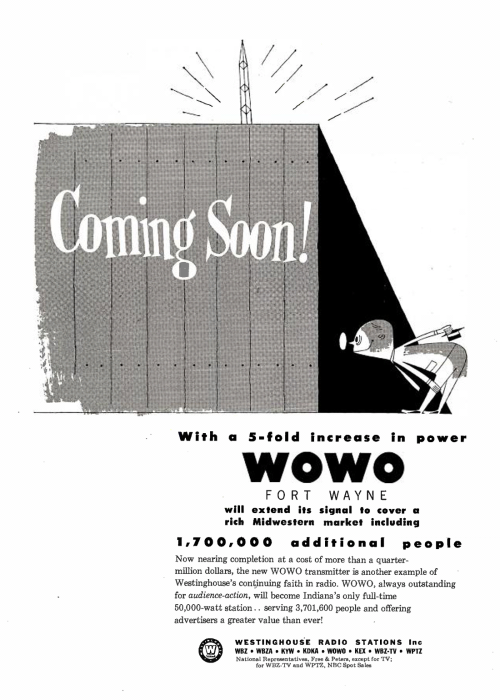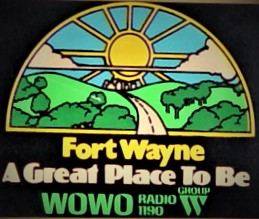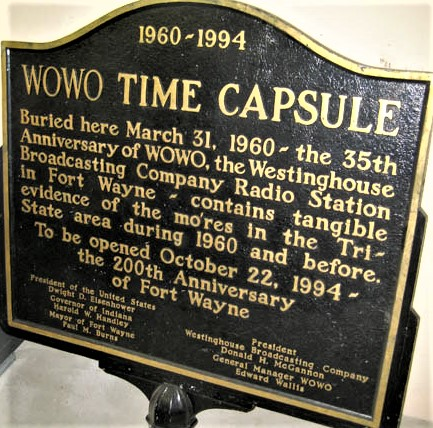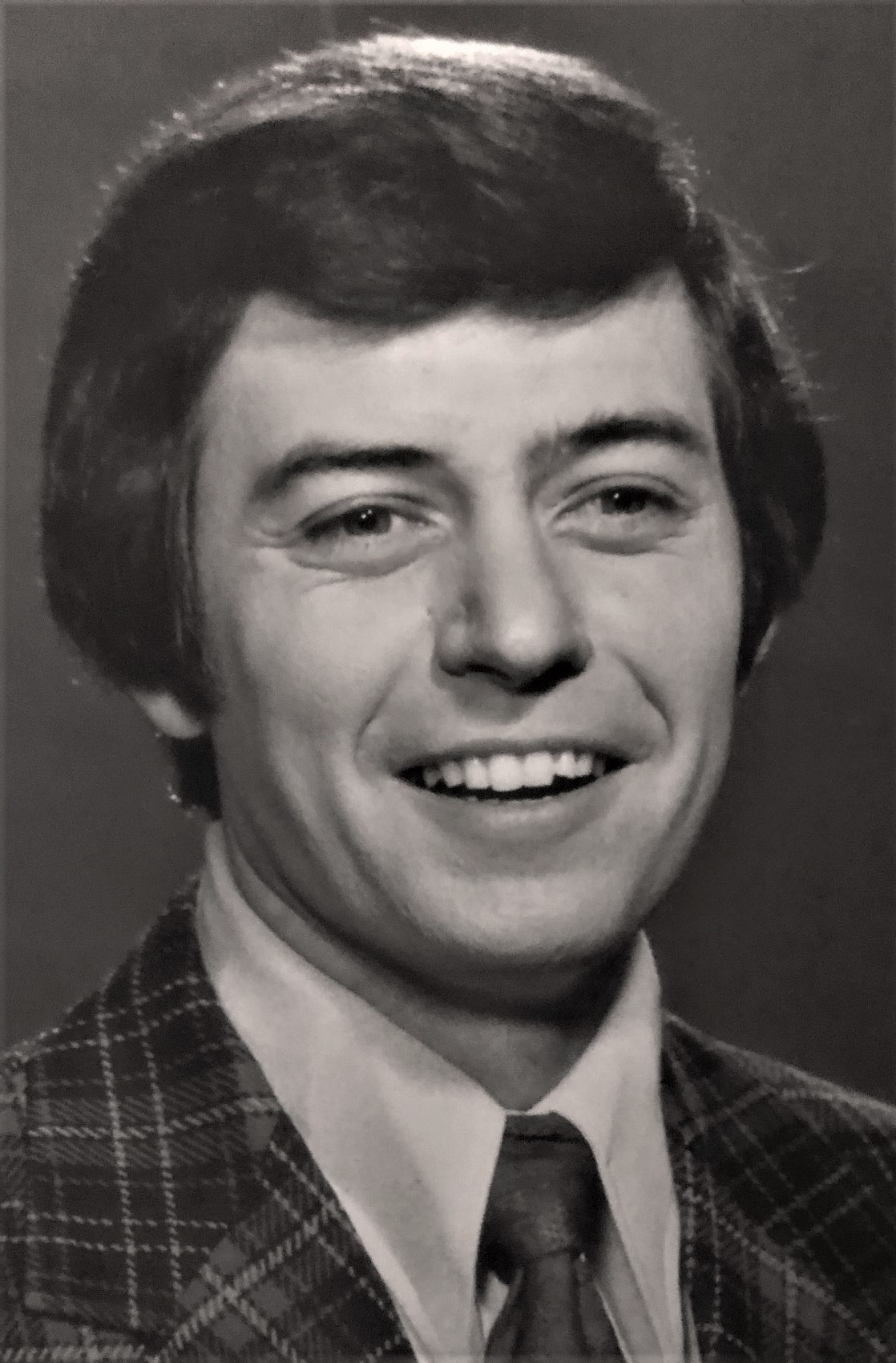
 Anyone who grew up in the Midwest (I didn’t) will recall “Woe-Woe” radio. Likewise, anyone who worked in broadcasting in the Midwest (and I did) knows about WOWO in Fort Wayne, Indiana. If you’ve ever surfed your car radio AM dial while driving across America’s heartland—especially at night—you probably heard it.
Anyone who grew up in the Midwest (I didn’t) will recall “Woe-Woe” radio. Likewise, anyone who worked in broadcasting in the Midwest (and I did) knows about WOWO in Fort Wayne, Indiana. If you’ve ever surfed your car radio AM dial while driving across America’s heartland—especially at night—you probably heard it.
 I rolled into Fort Wayne (pop. 175,000) for a TV news job in 1976. There was little doubt who ruled the radio dial that afternoon. WOWO’s hit music signature was boosted by good on-air voices and a robust, well-stocked local news staff, with whom I knew I’d soon be contending. Clearly, WOWO’s on and off-air footprint was so pervasive, I recall feeling sorry for the market’s also-rans.
I rolled into Fort Wayne (pop. 175,000) for a TV news job in 1976. There was little doubt who ruled the radio dial that afternoon. WOWO’s hit music signature was boosted by good on-air voices and a robust, well-stocked local news staff, with whom I knew I’d soon be contending. Clearly, WOWO’s on and off-air footprint was so pervasive, I recall feeling sorry for the market’s also-rans.
Clear channel WOWO became Indiana’s only full time 50 KW station in 1954 with the installation of a state-of-the-art Westinghouse HG-50 transmitter. The power push was widely publicized, including an ad in Broadcasting Magazine. For a half century, WOWO was a 50 KW clear channel superstation at 1190 AM. It was also the first Westinghouse station, a 46-year ownership that extended through its heyday years and into the 1980s. WOWO was a multi-generational icon, with primary coverage in Indiana, Ohio and Michigan. It also had faithful listeners in over 20 other states and five Canadian provinces, where many got their first impressions of Indiana. WOWO’s local brass liked to boast it was the voice of a thousand main streets.

 WOWO had long been a personality-based information station, heavy on agri-farm coverage and extensive local and regional news and sports. Historically, it had solid years with network affiliations (CBS and NBC ). But in a 1956 surprise, it shocked many when it went independent and began playing rock and roll records. Group W backed, and may have inspired, that change, directing WOWO’s management to get on-air personalities closer to the listeners, the community and the hearts of Indianians.
WOWO had long been a personality-based information station, heavy on agri-farm coverage and extensive local and regional news and sports. Historically, it had solid years with network affiliations (CBS and NBC ). But in a 1956 surprise, it shocked many when it went independent and began playing rock and roll records. Group W backed, and may have inspired, that change, directing WOWO’s management to get on-air personalities closer to the listeners, the community and the hearts of Indianians.
Feeding Chickens, Counting Listeners
 Also catching my attention when I arrived in ‘76 was the close town-and-country mix of both bustling urban and rural farm lifestyles. The city enjoyed local payrolls of manufacturing and technology bigboys General Electric, Magnavox, International Harvester and others. Most of their operating plants literally bordered those massive corn fields that ran for miles in all directions.
Also catching my attention when I arrived in ‘76 was the close town-and-country mix of both bustling urban and rural farm lifestyles. The city enjoyed local payrolls of manufacturing and technology bigboys General Electric, Magnavox, International Harvester and others. Most of their operating plants literally bordered those massive corn fields that ran for miles in all directions.
Thus, the setting for Fort Wayne’s dominant radio station.
WOWO’s Lil’ Red Barn (Run Time 3:26)

 The Little Red Barn Show with Bob Sievers and Jay Gould, WOWO’s long-time farm director, and a cast of others, was a two-hour farm program. Aside from daily livestock and crop prices, there was chicken feeding and lots of Hoosier humor. Some called it a corny laugher. But nobody laughed at its high arbitron ratings—often 60 percent of the radio audience. For nearly 50 years, between 5 and 7 a.m., hundreds of thousands of Indiana home fires were lit, maybe twice as many cows milked and countless chickens fed to the morning sounds of WOWO radio—not to mention the legions of humans relying on the Little Red Barn morning team to get them to work or school on time. Sievers reverted back to WOWO’s pop hits format for the last three hours of his daily show.
The Little Red Barn Show with Bob Sievers and Jay Gould, WOWO’s long-time farm director, and a cast of others, was a two-hour farm program. Aside from daily livestock and crop prices, there was chicken feeding and lots of Hoosier humor. Some called it a corny laugher. But nobody laughed at its high arbitron ratings—often 60 percent of the radio audience. For nearly 50 years, between 5 and 7 a.m., hundreds of thousands of Indiana home fires were lit, maybe twice as many cows milked and countless chickens fed to the morning sounds of WOWO radio—not to mention the legions of humans relying on the Little Red Barn morning team to get them to work or school on time. Sievers reverted back to WOWO’s pop hits format for the last three hours of his daily show.
12-year old Elvis on WOWO, 1947
Sievers, who always played a song of inspiration on the Little Red Barn Show, had a classic Elvis Presley story. Sievers was likely the first to play a Presley record on the air. Without knowing who the singer was, he gave in to a begging mother of a 12-year old and played her son’s recording of How Great Thou Art back in 1947. It was well received. Five years later he learned that young singer was indeed Elvis. After Presley hit it big in the mid-’50s, he said in a live interview in Fort Wayne that back when he was a boy in Tupelo, Mississippi he often listened to Bob Sievers on clear channel WOWO.

Bob Sievers, A.K.A. “Mr WOWO,” had a legendary career. Born and raised in Fort Wayne, his radio love started as a high school freshman, when for four successive years he signed WOWO on the air every morning (after his daily newspaper deliveries) before he went to school. In 1936 WOWO hired him as a full time announcer, a career that lasted 48 years, and was only interrupted by U.S. Navy stints during World War II and Korea. His listener profile was perhaps unmatched—just about anywhere. Arbitron once listed him as the nation’s third most listened to morning personality. He waved off bigger market radio offers, choosing to keep his Fort Wayne community ties. He retired in 1984 and passed in 2007 at age 90.
Sievers was not alone in completing a near lifelong career at WOWO. Gould, the crusty Hoosier philosopher, poet and author, counted 45 years at the station. Bob Chase, the station’s sports director and local hockey play-by-play man, logged more than 50 years.


Two young lion deejays who helped bolster WOWO’s younger demographics through the ‘70s and ‘80s were Chris Roberts and Ron Gregory (who also each racked up more than 20 years). You’ll hear them (first Roberts, then Gregory) in the following composite audio from a tape I rolled during the 1976 Memorial Day weekend. A far cry from Sievers’ Lil’ Red Barn, these guys really boomed it out during WOWO’s flashback of “the spirit of 1966 weekend.”
WOWO aircheck May ’76 (Run time 8:00)
 WOWO’s nationally recognized success had numerous milestones. How many radio stations ceremoniously plant a time capsule, symbolically marking a trailblazing past with an eye to the future? WOWO did that in 1960—its 35th anniversary—complete with a Bob Sievers voice track and numerous items representative of 1960.
WOWO’s nationally recognized success had numerous milestones. How many radio stations ceremoniously plant a time capsule, symbolically marking a trailblazing past with an eye to the future? WOWO did that in 1960—its 35th anniversary—complete with a Bob Sievers voice track and numerous items representative of 1960.
I recall that well-publicized marker at Fort Wayne’s Swinney Park was almost a tourist attraction. In 1994, the city’s 200th birthday, the capsule was opened. It was a good piece of WOWO pubic relations and a novel bit of history for subsequent generations experiencing a whole different broadcasting landscape by the mid-90s.
The 1980s brought major changes to WOWO Radio. Group W sold the station to Price Communications for $6 million in 1982, a short time after some WOWO listeners were beginning to dial into the growing FM surge. In 1985, shortly after Gould and Sievers retired, the station rekindled its long dormant FM operation. Three years later WOWO-AM shifted to an original oldies music format, and in ‘89 the Little Red Barn Show was reduced to Sundays-only.
The WOWO Power Breakdown
The station went back to its adult contemporary format in 1992. Two years later the long and probably most exciting chapters of its life came to an end. That’s when WOWO’s full time clear channel status was breached by owners of the very New York City radio station most subservient to the Fort Wayne station’s long power grip on the AM 1190 dial  spot. WLIB, also at 1190, was long required to sign off at sunset to protect WOWO’s Class A night time signal. WLIB’s owner, Inner City Broadcasting, sought FCC approval to purchase WOWO and reduce its night time signal to Class B classification. Inner City succeeded, maintaining the station’s 50 KW daytime operation, and later cutting its after-sundown power to 9,800 watts, thus allowing WLIB to operate full time. Having achieved its goal, and per a written agreement, Inner City turned management of WOWO over to Federated Media, later a subsidiary of Pathfinder Communications. That was the end of WOWO’s long night time presence in distant states and provinces to the north, east and south. Essentially, the big 1190 became just another Indiana radio station, with a smaller, greatly reduced north-south signal pattern.
spot. WLIB, also at 1190, was long required to sign off at sunset to protect WOWO’s Class A night time signal. WLIB’s owner, Inner City Broadcasting, sought FCC approval to purchase WOWO and reduce its night time signal to Class B classification. Inner City succeeded, maintaining the station’s 50 KW daytime operation, and later cutting its after-sundown power to 9,800 watts, thus allowing WLIB to operate full time. Having achieved its goal, and per a written agreement, Inner City turned management of WOWO over to Federated Media, later a subsidiary of Pathfinder Communications. That was the end of WOWO’s long night time presence in distant states and provinces to the north, east and south. Essentially, the big 1190 became just another Indiana radio station, with a smaller, greatly reduced north-south signal pattern.
 WOWO has more than once changed its format to news-talk. In 2015, it celebrated the famous calls 90 years in broadcasting. Listener ratings show WOWO still number 1 in the market. The station’s overall legendary success has left an indelible mark on broadcasting that probably won’t be duplicated.
WOWO has more than once changed its format to news-talk. In 2015, it celebrated the famous calls 90 years in broadcasting. Listener ratings show WOWO still number 1 in the market. The station’s overall legendary success has left an indelible mark on broadcasting that probably won’t be duplicated.

 Note: Author, Ron DeHart, worked across town from WOWO. He was news producer and anchor for the 6 p.m. and 11 p.m. news at WANE-TV, the CBS affiliate in Fort Wayne, in 1976 and 1977. He held prior news broadcasting jobs at KDAL AM-TV Duluth, MN, KBFW Radio, Bellingham, WA and WAVY Radio, Norfolk, VA.
Note: Author, Ron DeHart, worked across town from WOWO. He was news producer and anchor for the 6 p.m. and 11 p.m. news at WANE-TV, the CBS affiliate in Fort Wayne, in 1976 and 1977. He held prior news broadcasting jobs at KDAL AM-TV Duluth, MN, KBFW Radio, Bellingham, WA and WAVY Radio, Norfolk, VA.
Credit and acknowledgement: Some archival material (photos and audio) included in this article is from the website http://www.historyofwowo.com QZVX encourages persons interested in WOWO Radio to visit the site. The webmaster, Randy Meyer, says: “The site is dedicated to the history of that earlier WOWO. Although I am the caretaker of this site, it would never have been possible without the kind assistance of many others. We hope this site brings back some great memories of the station that truly was ‘A Great Place To Be!’
Ron DeHart is a former newspaper and broadcast journalist and a retired Public Affairs Officer from both the U.S. Forest Service and the U.S. Navy/Naval Reserve. His historical accounts of Pacific Northwest broadcasting are published by QZVX.
View more articles by Ron DeHart

Holy Cow! I just saw this article in 2022. Very accurate and complete. I was so happy to be part of the WOWO history, and thanks Ron D. for the mentions.
Ron Gregory
WOWO 1973-1998